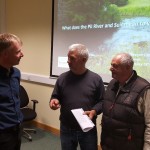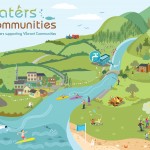Great turnouts and lively discussions were the order of the…
The Suir from Source to Sea – a public engagement pilot
Background
Flooding has been high on both the public and political agendas since the major flooding episodes in 2015. Most people agree that the protection of life and property from flood damage is a priority for any civilised society. How this is achieved and where flood measures or defences are placed depends on a lot of factors. Some of these factors play an important role in the management of flood water in the first place (e.g., landscape management) or relate to the value of a watercourse in terms of recreation, local economic or biodiversity etc. The management of flood risk is not simple and usually requires a holistic approach involving many actors in the field together with the public to ensure that the best outcomes for each flood risk area are achieved.
In July 2016, the Office of Public Works (OPW) scheduled six Catchment Flood Risk Assessment and Management public consultation days aimed at developing options to manage flood risk at ten locations within the River Suir catchment. The Waters and Communities office sits on the steering committee for the South- East Catchment Flood Risk Assessment and Management programme and it was proposed that a complimentary set of public consultations concentrating on the Water Framework Directive could provide a wider context to flood risk planning, encouraging people to think about and engage in their local water body and introduce the public to the Water Framework Directive objectives.
On request from the public who attended these meetings, an additional ten Waters and Communities Office led meetings were added to the original six. This resulted in meetings spread throughout the entire catchment from source to sea, covering counties Tipperary, Kilkenny, Waterford and Wexford. The meetings targeted some of the major tributaries and the main freshwater portion of the catchment together with the estuarine (transitional water) and coastal areas. The experience of the consultations provided the basis for the development of a template which would inform the Public Consultations of the draft River Basin Management Plan for 2018-2021 which took place between April and August 2017.
How were the meetings run?
The Office of Public Works Public Consultation meetings were open to the public from 13.00 to 19.00. Elected members also had the opportunity to attend from 12.00 to 13.00. Flood maps and potential flood management options were placed on public view with experts on hand to discuss and take any queries.
Catchments Newsletter
Office Water Framework Directive sessions took place immediately after the Office of Public Works public consultations. These meetings took the form of an interactive format (town hall); the primary aim was to actively engage members of the public in their local water body.
A local focus was maintained where possible by placing the overall catchment in the local context. The meetings were advertised with the caption “What does your River Suir mean to you?”. This question was tailored to the relevant waterbody where applicable (e.g., tributary or coast).
The concept of a catchment and how it applies to the River Suir Catchment was explained with examples of important features relevant to the meeting location. For example, the importance of the River Suir as a Special Area of Conservation (EU Habitats Directive) was highlighted and “features of qualifying interest” local to the area identified – for example, crayfish, otters or kingfishers.
The importance of the area for wider catchment community benefits was also emphasised (e.g., if the area is an important spawning area for salmon or trout, its importance in the context of the local economy or elsewhere within the catchment). The concept “the whole is greater than the sum of the parts” was explained in terms of tributaries and the wider catchment and how this applies irrespective of the perspective taken (e.g., economic, biodiversity, water quality, heritage etc.) – i.e., the tributaries and main channel are interlinked. People were encouraged to familiarise themselves with the Office of Public Works Catchment Flood Risk Assessment and Management plans and the flood management options being proposed for their local area and shown how to make submissions.
Included in this discussion was consideration of the wider community perspectives and the potential to find areas where added value could be made to any planned flood risk management option. At the basic level, people were encouraged to familiarise themselves of the plans and make informed submissions to the Office of Public Work’s Catchment Flood Risk Assessment and Management consultations. The activities of local groups carrying out work associated with water were acknowledged and examples given. This was followed with a subsequent discussion on the wider potential for such groups and new groups to come together and form wider partnerships throughout the catchment. The catchment partnership concept was introduced together with where the Waters and Communities office can provide support for communities wanting to get involved in the management of their local waters.
The Water Framework Directive was introduced, its background and objectives explained with an update on developments on where Ireland is today. The attendees were informed that the River Basin Management Plan consultation for the 2nd cycle would commence shortly. The Waters and Communities office was introduced and its role explained. Funding options open to the public were highlighted together with an explanation on how communities can get involved in the management of their waterways. Examples of projects led by community groups around the country were given and examples of the types of projects that communities can get involved in and what can be achieved shown. A proposal from the floor was that the Waters and Communities Office should organise an annual family Fun Day event, and rotate this between communities within the Suir catchment to promote the positive aspects of the catchment.
What happened at the meetings?
The presentations that were given were designed not to be generic. Each presentation was different and contained photos of the local waterbodies relevant to that area and other points of information that local communities could identify with. The idea here was not to deliver the usual generic presentations often associated with public consultations. In fact, we were warned by Local Authority colleagues that the public could be suffering from Consultation Fatigue!
Information for the meetings was gathered from many sources. Waters and Communities office staff used their contacts in other agencies to gather information on flooding, fishing, wildlife and local amenities from Local Authorities, Inland Fisheries Ireland (IFI), National Parks and Wildlife Services (NPWS) and the Office of Public Works together with data from the Water Framework Directive website Catchments.ie. A few days before each meeting they travelled to respective location and took photographs to use in the presentation. These were received very positively in the meetings as the images connected with the attendees and got the conversation flowing with locals. Preparatory meetings were held with Local Authority staff to discuss and plan for any contentious issues and identify potential opportunities where communities can engage.
Who attended the meetings?
Considerable effort was made to get people to come out and attend the meetings. Posters were placed in each meeting location, local radio interviews were given, articles published in the local newspapers, social media was used extensively following stakeholder analysis for each area to identify active groups etc., direct targeting of known local champions, various networks including those associated with the four local authorities (e.g. Public Participation Network, Local Community Development Committees, Heritage Fora, Elected members) covering the Suir catchment and Church announcements. People were interviewed on their arrival to the meetings to get a profile of who attended and their interest. It is clear from those that answered the survey on arrival that participants had a multitude of interests. 14% identified with all the options available on the attendee survey sheet.
What issues concerned most people?
Attendees were encouraged to identify the benefits of their local water bodies and share any issues which need to be addressed. Benefits ranged from water as an amenity, its importance to local commerce, farming and heritage, and many people shared stories about their local water course including their memories.
Issues raised varied. Some were common to most water bodies whist others were very specific to a particular waterbody (e.g., a pipe contributing pollution). The most commonly identified issue was “lack of joined up thinking amongst agencies” and “too many agencies involved in water management”.
The public are confused and unsure where to turn to about water management issues. For example, who does one talk to about problems associated with vegetation control if river bank trees are causing excessive shading or blockages? Conflicting views were common also where an issue to some was perceived as a benefit to others.
Other areas of concern included flooding and river management. Often, water quality itself did not feature strongly at all meetings. People did however associate with different water benefits, which in themselves are a proxy for water quality, or are influenced by water quality – for example, tourism, fishing etc.
Community Participation
A total of 339 attendees were recorded although this number does not include those too shy to record themselves on the attendance sheets!
The largest attendance was at Duncannon, a small village in Co. Wexford. The beach recently lost its “Blue Flag” status and locals were quite exercised about it. They identified the local sewage treatment plant as one of the main sources of pollution. They directly attributed the loss of the Blue Flag to it and accused it as having a direct impact on tourist numbers, which affected the local economy. The smallest attendance was in Ballyhack, which is located a few miles from Duncannon. The meeting was held a week after the Duncannon meeting. It was added on at a late stage, to facilitate a request by an attendee from a previous meeting, but was poorly advertised compared to the other meetings. Proving the adage “fail to plan – plan to fail”.
Public bodies
Officials from the Local Authority were present at all meetings (other agencies had personnel present at some of the events) and this allowed them the chance to mingle with the local community, explain their roles and discuss some issues which had been raised. One Local Authority official noted that the meetings were a great chance to catch several issues of concern, which otherwise would have been not recorded because of the burdens of their day job.
Outcomes
Culminating from these meetings a database has been set up with attendees contact details and regular feedback on catchment activities is provided. This network has proved invaluable recently as it facilitated a speedy response to the outbreak of the crayfish plague on the Suir. Information collected at the meetings is being collated and being acted upon -for example a submission was made to the Tipperary Heritage Plan based on feedback from the meetings.
The Waters and Communities Office have been working with several groups with a view to progressing river initiatives – a Freshwater Pearl Mussel project in Portlaw, biodiversity work in St Johns River Waterford, invasive species management throughout the catchment and community Family Fun Day events in Ardfinnan, Cahir, Carrick on Suir (Clancy Festival) and Sproai Waterford. The theme for this year’s Spraoi Festival street parade is “The River Suir – From Source to Sea”. After the conclusion for the meetings the Local Authority Waters and Communities Office were invited by elected members to present at Municipal District meetings on the local issues raised.
We would like to thank all of those who helped with the meetings, especially the Office of Public Works, the Local Authority staff, everyone who promoted the meetings including the elected members and of course the communities who attended. The learnings from these meetings went on to inform the draft River Basin Management Plan public consultations.
Fran Igoe, Michael Pollard, Alan Walsh and Sheevaun Thompson, Local Authority Waters and Communities Office







